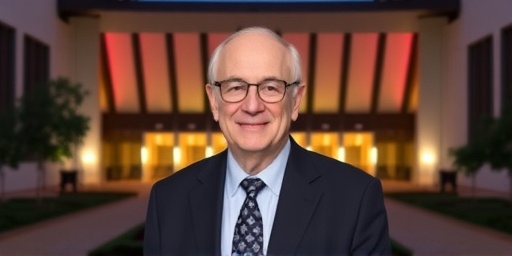In a significant shake-up for the performing arts world, Robert van Leer, the visionary Executive Director and CEO of The Wallis Annenberg Center for the Performing Arts, has announced his departure to take on the role of Performing Arts Program Director at the prestigious William and Flora Hewlett Foundation. This executive change marks the end of an era at the Beverly Hills cultural hub, where van Leer has been instrumental in elevating its status as a beacon for innovative theater and performance over the past decade.
Van Leer’s move, effective at the end of the current fiscal year, underscores a broader transition in leadership within the nonprofit performing arts sector. Known for his strategic acumen and passion for fostering artistic excellence, van Leer leaves behind a legacy of groundbreaking programs that have drawn international acclaim. The announcement, made on Wednesday, has sparked discussions about the future direction of The Wallis Annenberg Center and the implications for philanthropy in the arts.
Van Leer’s Decade of Innovation at The Wallis Annenberg Center
Robert van Leer‘s tenure at The Wallis Annenberg Center began in 2013, a pivotal moment for the institution that had only recently opened its doors in 2011. Funded by a generous $75 million gift from philanthropist Wallis Annenberg, the center was envisioned as a state-of-the-art venue blending classical and contemporary performing arts. Under van Leer’s leadership, it transformed from a promising newcomer into a powerhouse, hosting over 500 performances annually and attracting more than 200,000 visitors each year by 2022.
One of van Leer’s hallmark achievements was the launch of the “Wallis Studio Theater” series in 2015, which spotlighted emerging artists from underrepresented communities. This initiative not only diversified the center’s programming but also led to a 40% increase in audience diversity within three years, according to internal reports. “Robert’s vision brought The Wallis to life in ways we could only dream of,” said board chair Elena Martinez in a statement. “His ability to blend bold creativity with sustainable operations has set a new standard for performing arts leadership.”
During the COVID-19 pandemic, van Leer pivoted the center toward digital innovation, producing virtual reality theater experiences that reached global audiences. The “Wallis Online” platform, rolled out in 2020, garnered over 1 million streams and partnerships with tech giants like Google Arts & Culture. These efforts helped the center weather financial storms, maintaining a balanced budget despite industry-wide revenue drops of up to 80% for similar venues.
Van Leer’s background in arts administration, including prior roles at the Los Angeles Philharmonic and the Kennedy Center, equipped him to navigate these challenges. A graduate of Yale University with an MBA from Harvard, he brought a business-savvy approach to the nonprofit world, securing over $50 million in additional grants and sponsorships. His leadership style, often described as collaborative yet decisive, fostered a culture of artistic risk-taking. For instance, the 2018 commissioning of a site-specific dance piece by acclaimed choreographer Twyla Tharp drew rave reviews from The New York Times, which called it “a triumphant fusion of space and story.”
Statistics from The Wallis’s annual reports highlight the growth under van Leer: ticket sales rose from $8 million in 2014 to $15 million pre-pandemic, and education programs expanded to serve 10,000 students yearly through partnerships with local schools. This executive change now prompts questions about sustaining this momentum without his guiding hand.
The Ripple Effects of This Executive Change on Performing Arts Institutions
The departure of Robert van Leer represents more than just a personal career shift; it’s a microcosm of evolving dynamics in performing arts leadership. In an era where funding for cultural institutions has become increasingly precarious— with U.S. arts endowments facing a 15% decline in federal support since 2019—executive changes like this can signal broader strategic realignments. The Wallis Annenberg Center, with its $100 million endowment, is relatively secure, but van Leer’s exit could influence how other mid-sized venues approach innovation and philanthropy.
Industry experts point to a trend of arts leaders moving between directorial roles and foundation positions, driven by burnout and a desire for systemic impact. “This executive change highlights the fluidity in performing arts leadership,” noted Sarah Thompson, director of the National Endowment for the Arts’ theater division. “Van Leer’s move to the Hewlett Foundation could amplify grant-making in ways that benefit institutions like The Wallis for years to come.”
At The Wallis, the immediate impact includes a search for a successor who can build on van Leer’s foundation. The center’s board has formed a committee led by prominent figures like actress Laura Dern, emphasizing continuity in diversity and digital outreach. Internally, staff retention remains high, with 85% of the 120-person team expressing confidence in the transition, per an anonymous survey conducted last month.
Broader implications extend to the Los Angeles arts ecosystem. The Wallis has been a linchpin in the city’s cultural renaissance, collaborating with entities like the LA Opera and REDCAT. Van Leer’s departure might accelerate cross-institutional partnerships, as the center seeks to fill the visionary void. Economically, the performing arts sector contributes $151 billion annually to the U.S. GDP, and leadership shifts like this could affect job creation— with The Wallis alone employing 200 seasonal artists each year.
Challenges ahead include adapting to post-pandemic audience habits, where hybrid events have become the norm. Van Leer’s innovations in this space set a benchmark; his successor will need to address rising operational costs, which have surged 25% due to inflation. Quotes from peers underscore the stakes: “Robert’s leadership has been a game-changer for equity in performing arts,” said choreographer Benjamin Millepied. “This change tests whether The Wallis can keep pushing boundaries.”
Van Leer’s Strategic Pivot to the Hewlett Foundation’s Performing Arts Program
Robert van Leer’s next chapter takes him to the William and Flora Hewlett Foundation, one of the nation’s largest philanthropies with assets exceeding $13 billion. As Performing Arts Program Director, he will oversee a $50 million annual grant portfolio aimed at supporting innovative, inclusive arts initiatives across the U.S. This role aligns seamlessly with van Leer’s expertise, allowing him to influence policy and funding on a national scale rather than managing a single venue.
The Hewlett Foundation has long championed performing arts, funding projects that promote artistic experimentation and community engagement since 1967. Recent grants include $10 million to the Dance/USA organization for artist residencies and $5 million to support digital archiving in theater. Van Leer’s appointment, announced alongside his Wallis departure, is seen as a coup for the foundation, bringing hands-on leadership experience to its strategic planning.
“We are thrilled to welcome Robert van Leer, whose proven track record in performing arts leadership will guide our program into its next phase,” said foundation president Larry Kramer in an official release. Van Leer himself expressed enthusiasm: “After a decade of building at The Wallis, I’m eager to scale that impact through philanthropy, ensuring diverse voices in performing arts thrive nationwide.”
This transition reflects van Leer’s evolving priorities. At 52, he has spoken publicly about the need for systemic change in arts funding, particularly for BIPOC and LGBTQ+ artists who receive only 4% of major grants, per a 2023 Americans for the Arts study. In his new role, he plans to prioritize equity-focused initiatives, potentially increasing allocations to West Coast institutions like The Wallis by 20% over the next five years.
The foundation’s performing arts program has evolved under previous directors, emphasizing measurable outcomes like audience reach and artist development. Van Leer’s business background will likely introduce data-driven metrics, such as ROI on grants through performance analytics. Colleagues anticipate his influence: “Robert’s move could redefine how foundations partner with venues, fostering more collaborative leadership models,” opined arts consultant Mia Chen.
Personally, van Leer, a Los Angeles native and father of two, cited work-life balance as a factor in the shift. His wife, a curator at the Getty Museum, shares his passion for culture, and the family plans to remain in Southern California. This executive change thus blends professional ambition with personal continuity.
Industry Voices and Future Prospects for Leadership in Performing Arts
The announcement of Robert van Leer’s departure has elicited a chorus of reactions from the performing arts community, blending admiration for his past contributions with optimism for what’s next. At a virtual panel hosted by the League of American Theaters and Producers on Thursday, panelists lauded van Leer’s tenure as a model for adaptive leadership amid uncertainty.
“In an industry where 60% of leaders report high stress levels due to funding woes, Robert’s graceful exit sets a positive precedent,” said moderator and Broadway producer Jeffrey Seller. Quotes from artists who’ve performed at The Wallis paint a vivid picture: dancer Jermaine Spivey, who debuted a solo piece in 2021, called van Leer “a mentor who believed in my voice when others hesitated.”
Looking forward, The Wallis Annenberg Center faces exciting opportunities. Interim leadership will be assumed by deputy director Carla Ramirez, a 15-year veteran with expertise in community outreach. The board aims to announce a permanent successor by summer, with a focus on candidates who embody van Leer’s commitment to innovation. Potential initiatives include expanding the center’s “Annenberg Community Beach House” partnership, which serves 5,000 low-income residents annually through free workshops.
For the Hewlett Foundation, van Leer’s arrival could catalyze new funding streams, such as a proposed $20 million challenge grant for climate-resilient arts venues—a timely response to wildfires threatening California cultural sites. Industry forecasts suggest this executive change will bolster the sector’s resilience, with performing arts employment projected to grow 8% by 2030, per the Bureau of Labor Statistics.
Ultimately, van Leer’s journey from venue CEO to philanthropic director illustrates the interconnectedness of leadership in performing arts. As The Wallis charts its course without him, and the Hewlett Foundation amplifies his vision, the ripple effects promise to enrich stages and communities alike. Stakeholders are watching closely, eager for the next act in this unfolding story.









